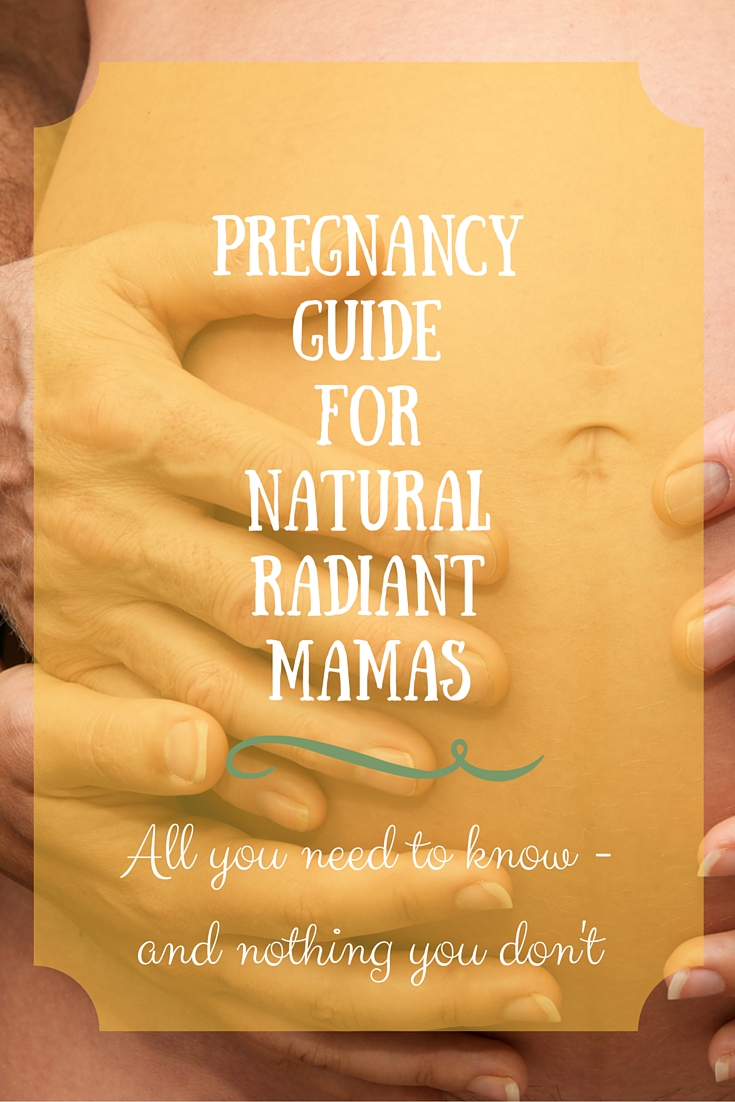[mk_fancy_title style=”avantgarde” tag_name=”h2″ size=”20″ line_height=”24″ color=”#393836″ font_weight=”inherit” letter_spacing=”0″ font_family=”none” margin_bottom=”10″ align=”left”]Index:[/mk_fancy_title]
Before pregnancy:
- Preparing to get pregnant
- Conception-boosting practices
- Lifestyle related changes before getting pregnant
- Supplements
During pregnancy:
- Diet
- Lifestyle related changes
- Pregnancy supplements
- Supplements for specific issues
- Practices and ideas that will support you during pregnancy
- Things to buy before week 36
After baby is born:
- Postpartum checklist
- What to do and not to do during week 1-12
- Postpartum supplements
- Meal train and postpartum support
- Information about hiring a postpartum doula
- Swaddling
- Sleep sharing
- Breastfeeding
- Pumping, storing milk and introducing a bottle
- Kegels
- What to put in diaper bag
- Sex after giving birth
- Boulder-specific practitioner list
- Helpful books
- Work with me + ending notes
Welcome, amazing mama!
I am so glad you are reading this because I know just how confusing and overwhelming it can be to want to get pregnant, be pregnant, give birth or be a new mother! It’s one of the biggest rites of passage a woman can experience in her life.

As I complete this pregnancy and postpartum guide, our amazing daughter is a little over 4 months old and an absolute joy. This has been a magnificent and wondrous journey so far, and I am very much looking forward to what the future holds for us.
I am thankful to report that my preparations before conceiving (including lifestyle choices and practices over the last two years) have truly paid off. I got pregnant on the first try, enjoyed a relatively smooth pregnancy, had a natural, empowering birth at home, felt strong and mentally well in my postpartum time and most importantly: our daughter is thriving!
Below you will find the practices that I found most helpful during this journey. My hope is that it will be supportive to you in your process of becoming or being pregnant, giving birth and being a new mom. If you’d like to read my birth story, click here!

Trust and Surrender
You and I both know that there are absolutely no guarantees. Doing everything “perfectly to a T” (other than certain dietary recommendations that are crucial to the best development for your baby) does not guarantee any specific results. I ask that you work on accepting that the whole process of birthing a child is more about trust and surrender than anything else.
Before reading any further, please take a moment and let these attitudes sink in.
Much of what I describe here is my own very positive experience of pregnancy, birth and postpartum. However, difficult pregnancies, births and postpartum depression are very real and common experiences. I encourage you to get as much support as possible to prepare for this – like I did. The most important part is your postpartum time, which is the most challenging for a majority of women (watch this awesome TED talk to learn about some parenting taboos that you definitely want to know about).

Let me know if you have any questions by emailing me at:
[email protected]
If you would like to schedule a pregnancy and/or birth preparation session with me, I offer them via phone or Skype. If you find this guide helpful, please let me know via email or by leaving a comment below. You can also share it on social media or with other mamas-to-be.
With love and excitement for your adventure,

PS. In this guide I will refer to your baby as “hen” – a Swedish gender neutral pronoun – so I don’t have to keep writing “he/she.” Those crazy Swedes have some cool ideas…
LOVE NOTES
Before I go any further I’d like to acknowledge the women choosing not to have a child:
I believe that deciding not to have a child is a very personal choice, and that not all women need to be a mother. I salute you and your path and know that you will have a rich and fulfilling life. If you ever feel the need to love on a child, there are plenty of kids in the world who could use some extra love!
A love note to the women who are not able to conceive or have a child:
Infertility is a challenge for many women today. It’s never easy, and it’s a big life challenge to overcome. My heart goes out to you and I am sending you so much love. I believe in you and your life’s journey. You are not alone, so please remember to ask for the help and support you need.
If you or a loved one need support around infertility, here’s a link to a wonderful woman named Justine Froelker, therapist and author of Ever Upward: Overcoming the Lifelong Losses of Infertility to Define Your Own Happy Ending.
For the many women who have lost a child through miscarriage:
You are not alone. Miscarriages happen to women of all ages and are such a difficult part of the process of trying to conceive. It’s important to understand that feelings of guilt, extreme loss, depression or shame are all normal after losing a baby (regardless of when it happens), and we need to start talking about these things (!). Find a trusted friend or group that can help support you if you feel like you need it. You are NOT alone.
PRE-PREGNANCY
3-12 months prior to wanting to conceive – cleanse. I did a cleanse 3 and 9 months before conceiving our daughter to prepare my body for pregnancy and create the most optimal environment for my child. Not only did I cleanse my body, I also spent lots of time healing past sexual trauma and practicing embodiment.
There are many cleanses out there, and I have probably tried most of them in my past life as a health nut. My absolute favorite is the 10-day transformation by Purium. It’s a whole, super foods based cleansing and healing system that is completely vegan and organic. It also includes protein and can be completed successfully while working. I’ve seen it work for myself and others time and time again.
If you would like to know more about the company and how this works before buying a product, feel free to email my husband KB at: [email protected], or if you are ready to buy the cleanse, please visit this website and use the $50 gift card code: livnau. The Purium cleanse (combined with a clean diet and fun movement) gave me a body that both felt and looked amazing – the best body I’ve had in my life!
Preparing to get pregnant:
Before reading on, watch this illuminating video on preparing for pregnancy:
Conception-boosting practices:
- Mayan abdominal massage
- Acupuncture
- Massage
- Cranial sacral work
- Chinese herbs
- Ayurvedic support
- Yoga
- Dance
Lifestyle related changes before getting pregnant:
- Start taking a prenatal whole foods vitamin.
- Dieting, especially low calorie or low fat diets are counter-fertile. Focus on eating a whole food diet with lots of healthy fats – organic when possible.
- If you’re taking birth control pills, try and get off them at least 6 months before you’d like to conceive (before you cleanse), but ideally give yourself a year and a half off the pill before trying to conceive.
- Get new carpets at least a year before your baby comes home so they can “de-gas.”
- Look for all-natural cleaners, shampoos, soaps and household products.
- Change your beauty products to all natural, organic versions as the skin will absorb whatever you put on it. I recommend Acure for an affordable option and Purium for an amazing skin changing option.
- Start slowing down, a stressed out body is less fertile due to the high levels of stress hormones we produce.
- Make sure the baby’s room (if you have one) is properly ventilated to avoid the onset of asthma.
- Give some thought to when you’d like to give birth. Middle of winter can be tough…
- Figure out when you ovulate. Period-tracking apps are tremendously helpful. I used “Period Tracker” for Mac.
- Have some conversations with your partner about his or her expectations and fears. Communication is key.
- Make sure you get enough sleep.
- Ask your partner to get healthy and calm with you. It’s much easier if you have a partner in this process, and hen will need the energy…
Supplements to take:
- Fish oil
- Pre-natal multi vitamin – with folic acid
- Vitamin C
Optional awesome additions:
- Pure Extra Virgin Coconut Oil: healthy fat, also great during pregnancy and while nursing
- Master Amino 23: pre-digested vegan protein that builds muscle
- Purium Power Shake: for me it’s been preferable to a standard multivitamin. Some of what it contains:
- Organic Spirulina: a blue-green algae that’s extremely nutritious and contains protein, B vitamins, minerals and trace minerals
- Rice Bran Solubles: a great source of the vitamin E type tocopherols and tocotreinols, vitamn B-1, B-2, B-3, and B-6, as well as co-Q 10, gamma oryzanol, folic acid and beta sitosterol
- Activated Barley: the ultimate slow burning, complex carbohydrate betaglucan powder, Activated Barley gives you sustained energy for 2-3 hours. Great for heart and circulatory health, it helps maintain healthy blood sugar levels and boosts the immune system. According to many studies, Beta Glucan can also build immunity by activating macrophages that trap and consume foreign substances in the body
- Carrot Juice
- Vitamin C: my go-to vitamin to keep healthy and strong

DURING PREGNANCY
Diet:
I’m excited to tell you that pregnancy is a normal physiological state of being! Lucky for us, we live in a time when it’s well known that appropriate nutrition can prevent many of the common complications of pregnancy – and we have the power to do something about it.
Guidelines:
- When possible, get organic produce and meats.
- Eat approximately 2,500-3,000 calories per day after month 3.
- Drink 2-3 liters of water per day – your pee should be pale.
- Up your iron intake. Here’s a good article on getting enough iron.
- Use more high quality sea salt in your diet – it may help reduce swelling and other problems (yes, this is different from advice given to non-pregnant women).
- Every day, aim for a varied diet including:
- Fresh veggies, especially green leafy vegetables, fruit, whole grains
- Clean protein: chicken, fish, turkey, beef, dairy, beans, nuts and seeds
- Healthy fats: nuts, avocado, olive oil, coconut oil, ghee
- Naturally occurring calcium: dairy products, broccoli, and leafy greens like kale, mustard greens, collards, turnip greens, and beet greens. For more info about calcium, go here
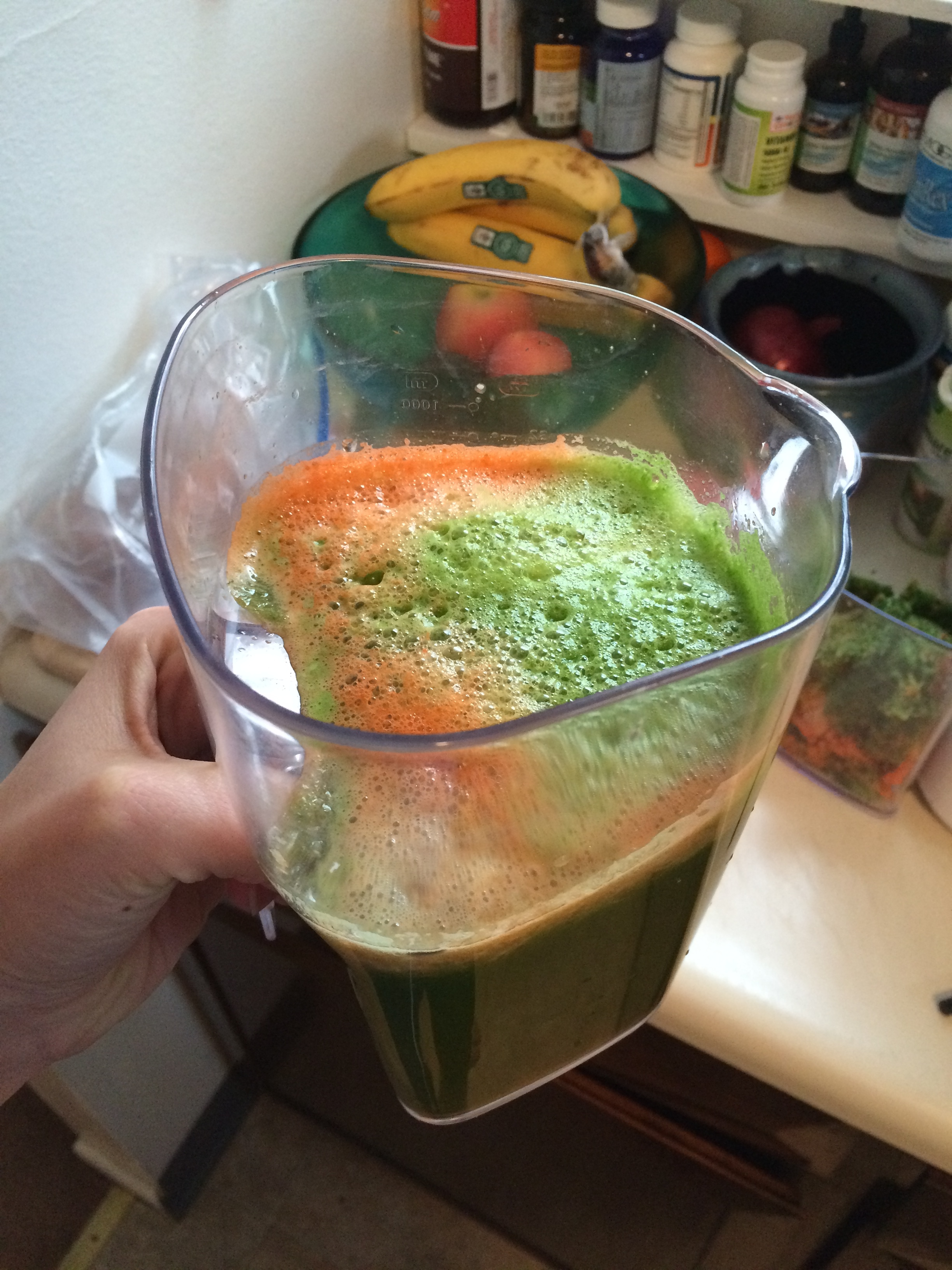
Minimize intake of:
- Refined foods
- Sugar
- Alcohol
- Caffeine – try switching to decaf coffee or tea
- Artificial sweeteners
- Over-the-counter drugs
Don’t eat:
- Swordfish
- King Mackerel
- Tilefish
FULL DISCLOSURE: In the nutritional and supplement guides I am recommending various supplements including products by a company called PURIUM. I am an independant distributor of this company, and if you choose to join the referral based company and buy products using my $50 gift certificate, I will receive money. You can also buy these products without becoming a member and pay the higher retail price. Another option is to buy similar products by other brands, but I cannot verify their quality or status as organic, non-gmo, free of fillers and pesticides, etc. If you would like to know more about the company and how this works before buying a product, feel free to email my husband KB at: [email protected], or if you are ready to buy a product, please visit this website and use the $50 gift card code: livnau
Lifestyle related changes
- This is not the time to worry about dieting and your weight. I struggled with disordered eating in my teens and early twenties and know these feelings can be stirred up during pregnancy. If this is the case with you, contact me and I will let you know how I can help.
- Look up any supplements before using to make sure they are safe for pregnancy. Ideally, consult your midwife and not the Internet.
- Figure out what causes you stress and minimize those things! You want your baby to have a calm, centered mama.
- Find movement that works for you.
- Find time to be in and connect with nature.
- Considering Hypnobirthing and find a program near you. Listen weekly to the Hypnobirthing meditations to help prepare you for giving birth.

Here’s a great article about getting pregnant naturally.
Supplements to take during pregnancy:
Daily:
- Prenatal vitamin – use a whole foods based supplement
- Probiotics
- Iron (if needed) – Floradix is a good, vegetarian and non-constipating form of iron
For specific issues:
- Leg cramps, relaxation and sleeping: Liquid Calcium/Magnesium supplement at night.
- Acid reflux and digestion aid: Papaya enzymes or other digestive enzymes.
- WishGarden tinctures specific for pregnancy:
- Stress relief
- Immune boost
- Constipation: drink plenty of water, eat lots of fiber, take magnesium, practice daily relaxation techniques, make sure you walk and move. I like this article for more in-depth help.
- Yeast infection: Homeopathic remedies can be really helpful and safe for pregnancy.
- UTI (Urinary Tract Infection): I got a UTI and was able to heal it naturally without antibiotics. It took a lot of rest, fluids, vitamin C and focus to do it, but it worked. If you need to take antibiotics, remember to follow them with probiotics. Here’s a helpful article about UTIs and natural support.
Things to consider and help you during pregnancy:
Pregnancy is an amazing time in your life where you get to experience the miracle of growing another human being! Just writing that sentence sends goose bumps down my arms. Unfortunately, the western world has forgotten to treat and respect this time as the powerful, transformative experience it actually is. Many women feel pressured to keep going at the same speed as they were before getting pregnant, almost pretending like everything is as it was before. Please, believe me when I say IT IS NOT!
Pregnancy is your time to create healthy boundaries, slow down, rest, enjoy yourself and care for yourself and your baby the best you can.
Below you will find some ideas and attitudes for each trimester that I hope will be helpful for you. I believe it’s super important to keep moving and eat as nutritionally you can. Labor is, as the name implies, a taxing and arduous experience, no matter how ecstatic it may be, so you need to be in as good shape as you can (without over-doing it).
As you know, pregnancy is not an exact science, and it’s not the same for every woman. Quite the opposite. To that end, please adjust this timeline as it applies to you.
First trimester
The first trimester is a crazy time. First, you have to adjust to the little blue line actually showing up on the test. It’s really happening!
There can be lots of emotional up and downs as pregnancy hormones start surging through your body. If you have had a miscarriage in the past, you might also feel nervous or scared. Nausea might be setting in and you can start feeling tired and need to sleep more. Pregnancy experiences vary tremendously from person to person, and even pregnancy to pregnancy. If you are so lucky that your symptoms are fairly mild, enjoy this time! If, on the other hand, you are puking what feels like every five minutes – I feel for you and you can do this!
As I mentioned before, our culture has failed to give us the message that pregnancy is a special time that requires special adjustments so your baby can attach securely and develop healthfully. Women are expected to work up until the end of their pregnancy, performing just as they did before they were pregnant. To me, this is highly unfortunate and not good for either mama or baby. I am not going to dive too deeply into the developmental aspects of pregnancy, but if this is of interest to you I highly recommend reading this book by my friend Annie Brook: From Conception to Crawling.
Remember this: Your body knows exactly what to do to to create this baby. Your job is to create a low-stress, high-nutrition environment for your baby and keep moving your body.

Here are some attitudes and adjustments to adopt that will benefit you and your baby:
- Start slowing down.
- Find ways to de-stress.
- If you are throwing up a lot, consider these superfoods products to help you feel comfortable knowing that your baby is getting amazing nutrition while you are not able to eat so well: Predigested vegan protein tablets, Master Amino 23 and L.O.V. protein shake.
- Find ways to lessen the pressure you might have on yourself.
- Ask for help at work. Try to have conversations with your supervisor (if you have one) about your commitment to your work, but also to your pregnancy process.
Movement:
If you are able to, keep your body moving during your entire pregnancy. Before you are so big that bouncing becomes a problem, do whatever exercise you were doing before being pregnant. Hiking, dance and yoga are some of my favorites because they promote the embodiment you will need to birth that bebe. A good friend of mine was suddenly drawn to weight lifting, so just do what feels right to you.

- Stay with me.
- This too shall pass.
- I am amazing! My body is creating a human.
Second trimester
In this period your energy will start returning and you will feel great! This is your time to enjoy the shit out of being pregnant (for some it will be more challenging, but I’m holding your best and highest experience in my heart).
Your skin is glowing, your breast are fuller and your hair is thicker. After approximately week 20 you will also start feeling your baby move. This is the most amazingly beautiful experience. There really is no way to properly describe the sensation, but it’s guaranteed to blow your heart wide open. Work on bonding with your baby and allowing your partner to do the same. Sing, stroke your belly and play soft music to your growing child. Keep slowing down your life. Enjoy being in nature and doing things that make you feel alive. Share with your baby how safe hen is and what a wonderful place this earth is to live on!
This time is one of rapid growth for both you and baby. You will feel more safe that this is actually happening and start contemplating and preparing for all the upcoming changes. And your baby will be developing at a mind-blowing pace. You might start feeling super creative during this time, so enjoy it – but don’t let it overwhelm you.

Movement
Since you may have more energy than in your first trimester, use it to move and stay fit and healthy. Do whatever exercise feels right for you, moving from a place of body love and avoiding a competitive mindset. Your uterus is starting to get heavier, so don’t do a lot of jumping exercises that will strain your pelvic floor muscles. But a little jumping won’t hurt. 😉
- We are growing together.
- I look forward to sharing this wonderful world with you.
- I’m here to support your growth.
Third trimester
Well done, mama! Just a few more months to go. I know they might feel long, but try to enjoy this time as much as you can. And learn how to not beat yourself up or feel guilty if you think it sucks!
If by the very end you just want to chill and eat delectable treats, do! Just make sure to keep moving your body. Bolster yourself with pillows at night to make yourself more comfortable. The waiting in the end can be quite brutal, so do whatever you need to support yourself through that.

Movement:
As you now have grown quite big, swimming can be an awesome addition to your movement routine. Try to find a saline pool if possible to avoid chlorine. After each movement session, lay down and practice deep relaxation and gratitude for your body. It’s working really hard to give you this baby. If you haven’t already, begin working with your breath and learn breathing techniques for relaxation.
- I’m ready when you are.
- I trust my body to give birth to my baby safely.
- My baby chooses his or her own birth story. It’s not my job to control it.
- Women have been giving birth to babies for centuries. I’ve got this.
- My body and baby will guide me in how to surrender to the birth process.
What to buy before week 36:
- All natural nipple cream
- Sitz bath herbs
- Peri-bottle
- Hemorrhoid cream
- Old lady panties
- Big pads with wings (huge overnight ones are the best)
- Arnica 30cc homeopathic pellets to help the body with trauma
- Bellis homeopathic pellets for healing perineum
- Baby bum cream with Zinc for diaper rash
- Baby nest
- Bouncy exercise ball
- Nursing tea
- Moby wrap

AFTER BABY IS BORN:
The 6 weeks after your child is born is a special time that will never come again! This is your time to bond as a new family. Everyone told me it would go fast, and it sure did, even though the each day itself felt super slow. It’s one of the more interesting paradoxes you will experience in life. Please do what I did and take this to heart. I promise you it will be one of the better choices you ever made. And don’t forget to take little video snippets to remember the time even better!
First week Postpartum checklist for mama and baby:
- REST!
- Feel where the top of your uterus is and massage it a few times every day.
- Take oral arnica: 30 cc homeopathic remedy.
- Take a daily sitz bath for perineal healing.
- Eat warm, nourishing, fatty foods and drink lots of water!
- Nurse your baby every 2-3 hours (even at night) the first week. Your baby’s stomach is the size of an almond, so hen will need to nurse frequently (and might overeat and spit up for this reason – see breastfeeding section below).
- CRUCIAL: Don’t leave your bedroom the first week. Stay in bed.
- Limit visitors to 30 minutes.
- Keep your baby warm. Newborns have a hard time keeping their temperature. My midwife recommended one more layer than what I wore comfortably.
- It’s normal for babies to sneeze a lot, and they also get hiccups! Use a humidifier if in a dry climate.
- Keep cord site clean and dry until it falls off. Fold down diaper off cord stump.

What to do and not do each week:
Adapted from Katie Wise’s Inspired Birth Class advice.
Week 1
Do:
- Stay in bed! Have your partner bring you food in bed and help you as much as possible.
- Do a sitz bath every day.
- Get some sunshine and fresh air through the window, and keep it open as weather allows.
- Support your back and arms with pillows while nursing.
- All of your energy goes to healing you and caring for your baby.
- Limit visits to 30 minutes.
- Snuggle skin-to-skin with your baby. This will promote bonding and healing.
Don’t:
- Think that it’s silly to stay in bed that long. It will be well worth it to heal your perineum and pelvic floor.
- Entertain for long periods of time. That can happen later, and you might tire yourself out more that you realize.
- Try to push yourself. REST! You sleep when baby sleeps.
Week 2
Do:
- Stay in bed as much as possible, in a horizontal position.
- Limit trips to the same floor, and make them small.
- Eat more than you think you need, snack between meals and get lots of protein.
Don’t:
- Get up and entertain. If you are up and clothed, people will assume you are more ready to socialize. You’re not! There’s plenty of time for that later.
- Forget to eat.
Week 3
Do:
- Start moving around the house, but no major projects.
- Go outside and sit in the sun (if weather permits).
- Learn how to wear your baby in a wrap. Moby wraps are best for newborns as they are soft and snuggly. Here’s a good video on how to wear it.
- Ask for help. It’s really fun for other people to help you during this time. It makes them feel special and happy.
- Encourage baby/partner bonding and give them time to get to know each other (this will be an ongoing thing).
Don’t:
- Do what I did and think you are ready to go out. It was super overwhelming and made me completely worn out. If you feel stir crazy, have a trusted girlfriend bring takeout to your house and watch a fun movie.
- Tell your partner how to be with your baby. Let them figure it out the best they can – because they will – and your partner will feel more empowered as a parent.
Weeks 3-6
Do:
- Start exploring your ‘hood and go for walks. No crazy hikes.
- Keep getting to know your baby. Really focus on what hen likes and what works for hen.
Don’t:
- Go grocery shopping or to Target with your infant. It’s too stimulating for their sensitive brains.
Weeks 6-12
Do:
- Introduce your baby to the outside world slowly.
- Start doing errands – but no more than one a day. If you overdo it, just take extra time in the next days to recuperate.
- Listen to your baby’s cues when in the arms of new people. Don’t let your baby cry to “get used to it.”
- Respect your baby’s boundaries, just like you would an adult’s.
- See if you can get to a breastfeeding class or postpartum yoga class.
Don’t:
- Keep your baby in the carseat as a babysitter. Keep your little snuggle-bunny nice and close to your body.
Supplements to take Postpartum:
- Coconut oil
- Fish oil
- Vitamin C
- MultiVitamin
- Greens
- Nursing tea
- Ayurvedic herbs if needed
Meal Train and help postpartum:
It’s very important that you set yourself up with lots of support after giving birth. You’re not meant to do it alone, and it’s not good for you or your baby to try and do so. Remember, you just birthed a human through your body – whether vaginally or through Cesarean birth – and that’s the most amazing and taxing accomplishment! Besides, people LOVE helping new mamas and you want to allow them the opportunity to give back in this beautiful way!
There are a few things to consider. One way to get support is to hire a Postpartum Doula as explained below. If you are not able to do so be sure to enlist your community to contribute to your budding family. One of the best ways to get help is to create a meal train and appoint a close friend as the organizer (Note to type A women – do not try and do this yourself.)
Here’s a link to a Google Doc Template that you can share with your meal train captain. Take some time to discuss what you think you’ll need and fill out the document before you have given birth, around week 36 to be safe. At this time, also give your captain a list of the people who have volunteered and their email addresses.
One other thing to consider is limiting the visits to around 30-45 minutes in the first couple of weeks. New motherhood fatigue can sneak up on you really fast if you spend time socializing for hours and then, if your baby is up for three nights straight it will be really hard. You need to conserve energy in order to meet the demands of being a new mom. I had a note on my door that I received from my midwife that you can see below, you may want to consider having a friend create something similar.
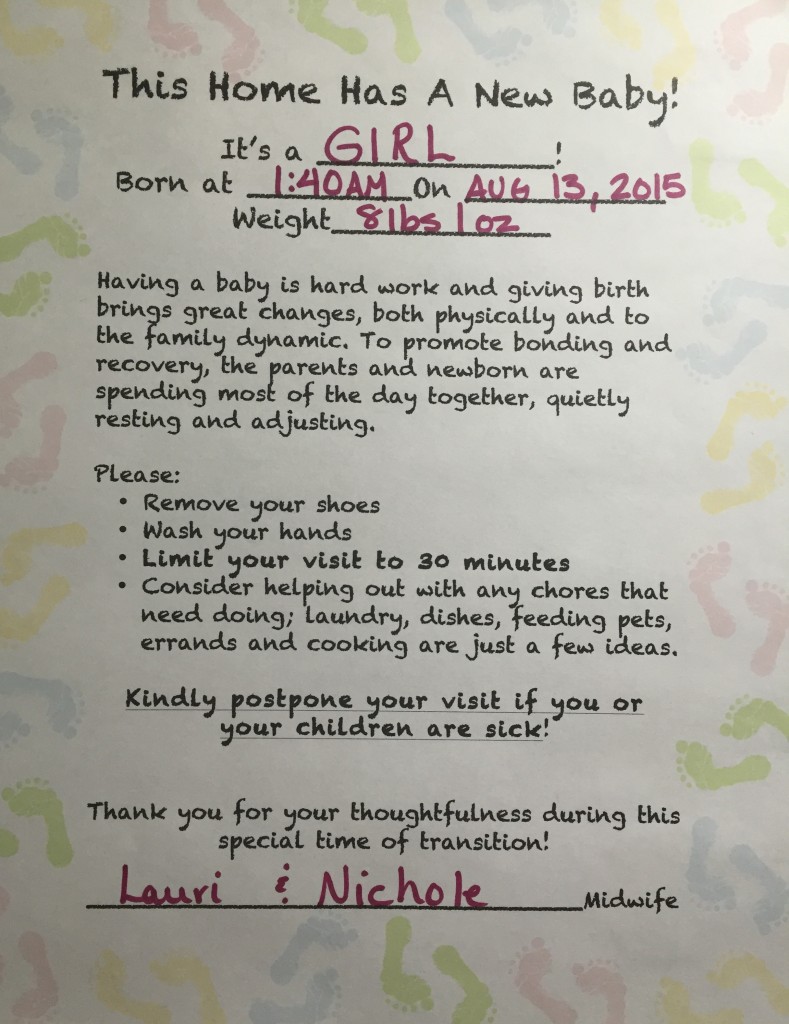
Hiring a Postpartum Ayurvedic Doula:
The best advice I ever got during my pregnancy was to hire an Ayurvedic postpartum doula. I highly recommend hiring a doula for the first 6 weeks of your baby’s life. Just knowing that I would have support, nourishing food, access to her wisdom, massage, physical and emotional help was so stress-relieving and truly helped me adjust to being a new mom. I strongly believe it can help with postpartum depression, as it’s such a big adjustment and loss of identity to become a new mom, in addition to being so amazing and wonderful.
Cost: It costs around $30-40 per hour to hire a postpartum Ayurvedic doula. I asked my family and friends to contribute to my postpartum doula fund instead of giving gifts, and that’s a good option for those who otherwise cannot afford this type of service. You can also hire a postpartum doula in training for a more affordable option.
What is a postpartum Ayurvedic doula?
A postpartum doula provides evidenced-based information on such things as infant feeding, emotional and physical recovery from birth, mother/baby bonding, infant soothing and basic newborn care. A postpartum doula is there to help a new family in those first days and weeks after bringing home a new baby. Research shows that moms, partners and babies have an easier time with this transition if a good support team is in place. An Ayurvedic postpartum doula also provides mama and infant massage, as well as food and herbs to support the transition.
Ayurveda is a 5,000-year-old system of natural healing that has its origins in the Vedic culture of India. Ayurvedic practitioners believe that the first 42 days (6 weeks) after birth set the stage for the next 42 years for the mother’s health, and for the baby’s health and happiness for life.
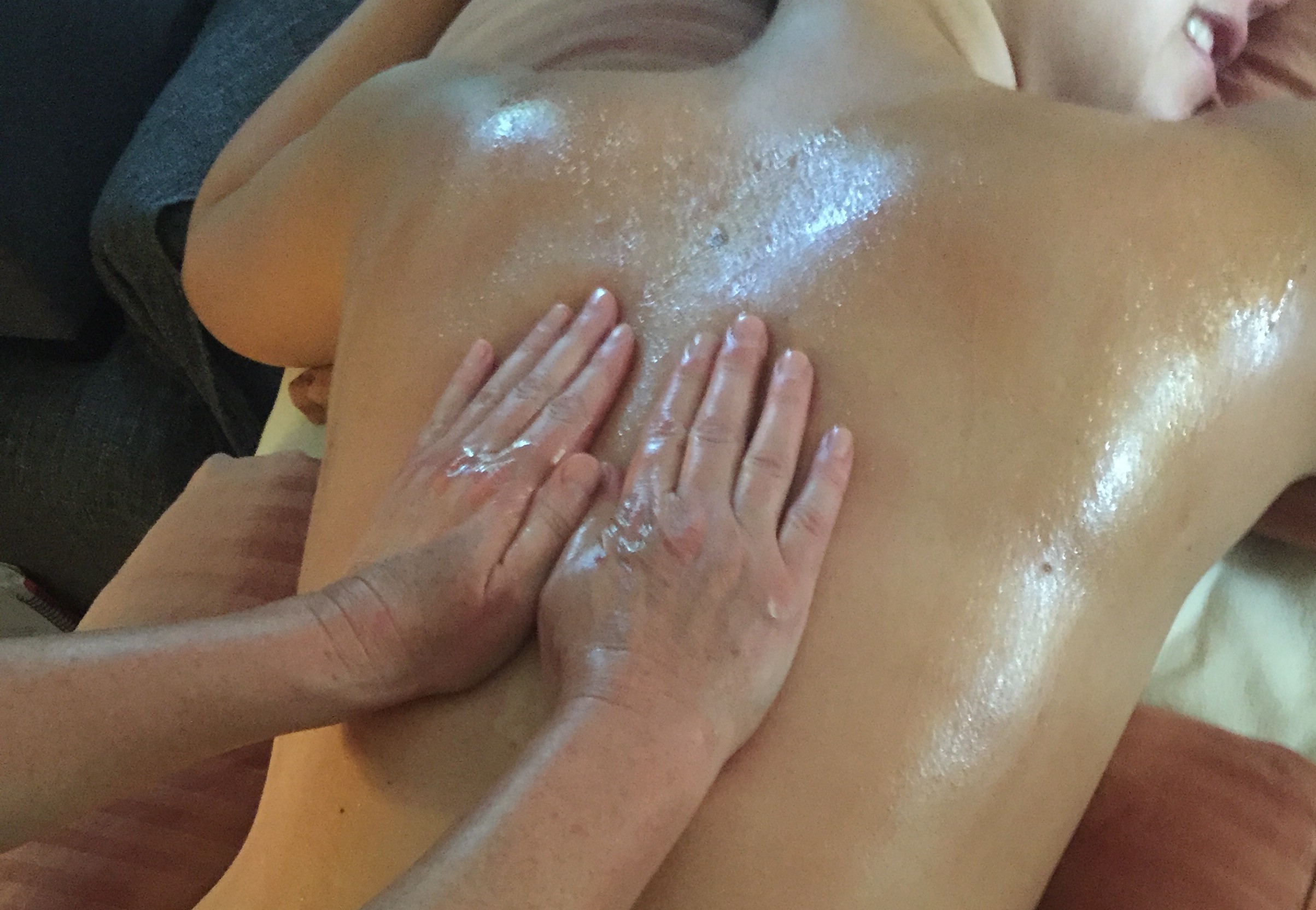
What do they do?
- Breastfeeding support
- Help with the emotional and physical recovery after birth
- Light housekeeping so that mom does not feel so overwhelmed
- Running errands
- Assistance with newborn care such as diapering, bathing, feeding and comforting
- Ayurvedic meal preparation
- Preparing herbal support remedies
- Ayurvedic postpartum massage
- Baby soothing techniques
- Sibling care
- Referrals to local resources
Most postpartum doulas provide service for a family anywhere from a few days up to a few weeks after bringing home a new baby. Families may have the doula work 1-3 days a week or as many as 5 days a week.

Swaddling:
When your baby is just born and for the following 6-8 weeks, swaddling will be an amazing way to soothe your baby and keep hen feeling safe. Since I spent most of my daughter’s first month in bed, skin-to-skin, we usually only swaddled at night. If you swaddle during the day, it’s best to stop daytime swaddling around month one.
Below you will find videos and articles describing how to swaddle your baby. Personally, we got a sleepsack that swaddles easily with velcro, but that’s up to you to decide what your preference is. Our daughter pretty quickly preferred to be swaddled with her arms out. If your baby starts liking being swaddled less, try that and see if it improves hen’s experience. (Don’t bother register for receiving or swaddling blankets, I assure you you’ll still have a drawer of blankets when all is said and done.)
Benefits:
- Baby feels safer
- Less crying
- Sleeps longer and better
- Less scratches
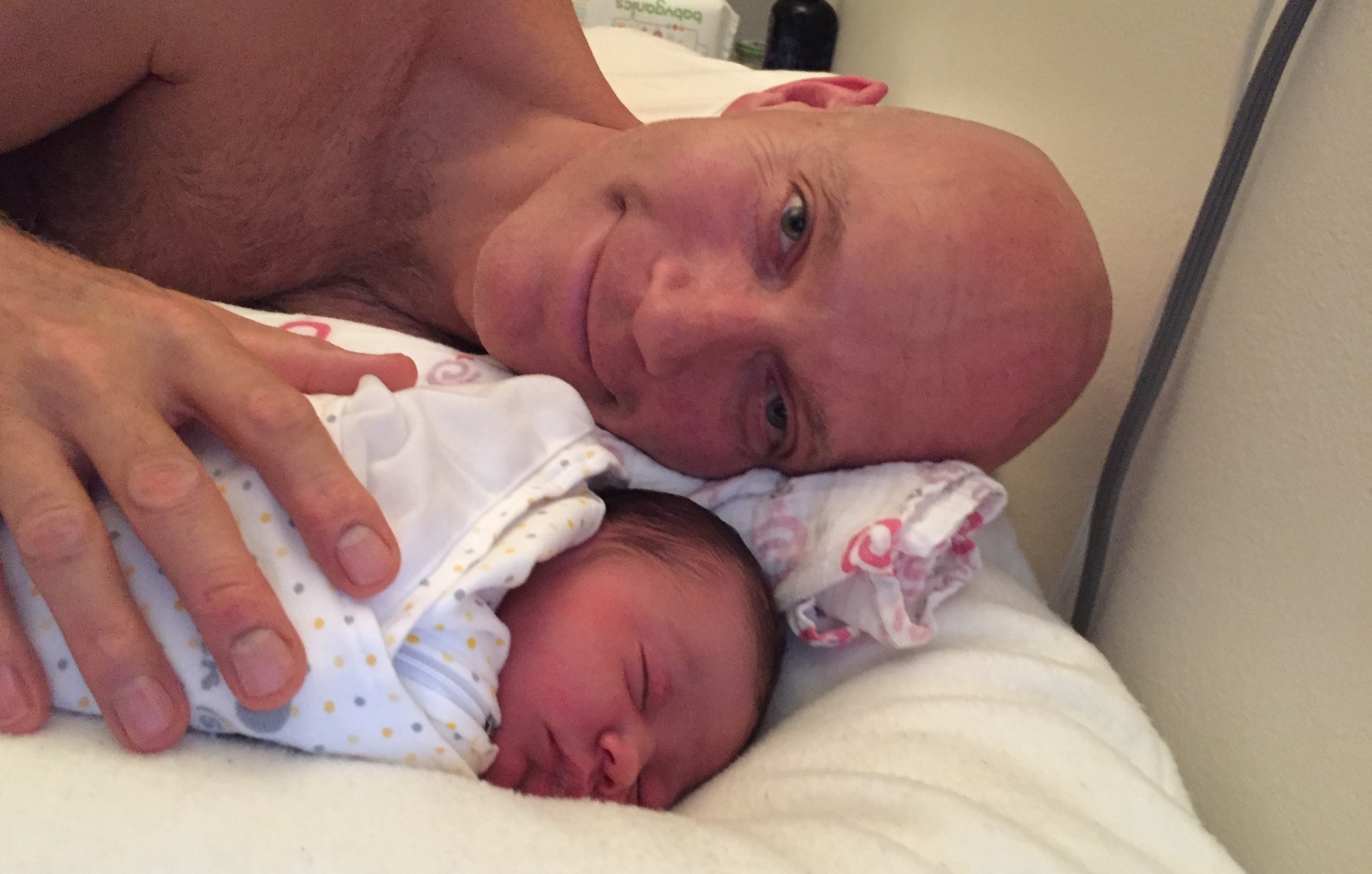
Sleep sack – example here
Two ways to swaddle – short video here
The benefits of swaddling and how to – long video here
Risks and benefits – article here
Sleep sharing:
How your baby sleeps seems to be a semi-controversial topic. I respect whatever a parent chooses for their baby, but that doesn’t mean that I don’t have a very strong opinion about what I believe is best for my baby. From my perspective, a baby who has spent the past 9 months INSIDE your body will be most comfortable sleeping near you for the first part of hen’s life. How long that period lasts depends on the baby and the family dynamics. At the point of writing, my daughter is almost 4 months old and sleeps either next to me in our king size bed or next to me in her little nest. You can find where to buy your own nest here.
Our time spent sleep sharing has felt very safe and comfortable, and I have never felt scared that I would harm her. It’s been one of the most rewarding and beautiful gifts to sleep together. I can now anticipate when she needs to nurse, and can feed her and put her back in the nest without waking her up. She basically sleeps through the night, meaning I mostly do, too. Of course, all children are different and will have their unique sleep patterns, but co-sleeping has been shown to have many major benefits including:
- Easy access to breastfeeding, and all of its benefits.
- Aids in bonding between mother and child.
- Co-sleeping babies grow up with a higher self-esteem, less anxiety, become independent sooner, are better behaved in school, and are more comfortable with affection.
- Less psychiatric problems.
- Safer than crib sleeping – reduced risk of SIDS.
Here are two great articles on the safety of co-sleeping and information on where you can find studies on the topic:
Ultimately, wherever you and your baby get the best night’s sleep is the right arrangement for your family.
Breastfeeding:
I am a big lover of breastfeeding! It’s bonding, it’s soothing, it’s convenient, it’s cheap, it’s so amazing and best of all: it has infinite health benefits to your baby. If you are able to nurse, do it! If you cannot, love yourself and come up with the best solution for your family.
I once thought breastfeeding wasn’t that big of a deal. After all, I had seen lots of mamas out and about, nursing on one side with a cup of coffee in the other hand. Surely not that hard, right? Wrong. I failed to realize that the moms I saw were probably nursing a 3 month infant or older. With 3 months of practice it looks like a breeze. But it’s quite a challenge at first!
I recommend looking at nursing as a skill to be mastered – one that takes a lot of consciousness and effort. There are many books on the topic, so I will just touch on the tips that were most helpful for me:
- For the first week, wake the baby up at night to feed about every two hours. Even though it’s tiring, it’s a great way to help your breasts to start producing milk – make it “come in” – and for baby to start gaining back their birth weight. If you do not wake up your baby to feed, there could be issues with milk supply and weight loss, with further complications stemming from that. After hen is back at hen’s birthweight, you can stop waking your baby up.
- In the beginning, apply all natural nipple cream AFTER EACH FEEDING. Because I listened to a good friend of mine who had to deal with cracked nipples (super ouch), I didn’t get sore or bleeding nipples. Cracked nipples can happen as you and your baby get used to breastfeeding, but can be avoided through nipple cream and appropriate positioning.
- Around weeks 36-38, start massaging your breasts and give them lots of love. Tell them that soon the baby will be born and then they will have to produce milk to feed the baby. Massage each breast in circular motions, clockwise. End by stroking them from the top of the breast down, and from the armpits toward the nipple to help stimulate the milk ducts.
- Find a doula or lactation consultant who can show you the correct way to nurse. Positioning and latch is key to good milk production, happy nipples and a happy baby and mama. You actually want part of the areola in the baby’s mouth, not just the nipple. It might take you some time to get good at nursing, as it’s a skill that you have to work on. If the baby finally latches but it’s not correct, try to release the suction by placing your index finger in the corner of baby’s mouth, next to you your nipple, and take it out gently. Then have the baby re-latch. It might sound tedious, but it is well worth it to get right.
- Watch this video to learn how to master the deep latch.
- You can use your fingers to pinch the breast to fit more easily in your baby’s mouth.
- Make sure the baby’s lips are flared out around your areola, not sucked into hen’s mouth.
- Be sure to vary your nursing position so that milk flows through all the milk ducts. Otherwise you can get clogged ducts or mastitis. If you notice a tender or sore lump, start massaging and working with it right away to avoid mastitis. In the winter, be sure that your breasts do not get cold, which also can lead to mastitis. I liked the football clutch in the beginning to get the nipple and areola in there, so be sure to give that a whirl.
- There could be issues with both oversupply and undersupply of milk. Just remember that both are things you can work with. Be sure to consult with a professional or attend a breastfeeding group to get the support and help you need.
Read an article on the accumulative benefits of breastfeeding here.
Read about the amazing backwash effect of your baby’s saliva getting sucked back into your breast – you don’t want to miss this!
Pumping, storing milk and introducing bottle:
Like many mothers, I have a love/hate relationship with pumping milk. It’s a whole science, and you may need to consult a specialist to get it right for your family. Here are a few tips I’ve picked up along the way:
- Since your supply of breast milk is determined on a supply and demand basis – meaning your breasts will make as much as you express – you might want to wait until you and your baby are in a good nursing rhythm to start pumping.
- I started pumping around weeks 3-4, and would store the milk in the freezer. Everything went smoothly at first and baby girl took the bottle well. But after a few weeks of bottle feeding she started fussing and crying every time my husband tried feeding her. I figured out that my milk has excess lipase which causes the milk fat to break down, even in the freezer, which makes it taste bad. Read more about that here.
- I figured out that if you heat the milk it stops the enzyme from breaking it down, your mildly pasteurizing the milk (be sure not to boil it.) Consider adding an enzyme back to the milk before giving it to your baby if you are giving hen a lot of thawed out milk.
- After pumping your milk put it in the fridge before freezing it.
- Store the milk in a deep freezer, and make sure it stays cold.
- In case of over supply it may cause the baby to have a hard time nursing, you can hand express some milk before each feeding to make it easier for your little one. You’ll notice this by your baby getting fussy at the nipple, or frequently latching and then pulling off the nipple quickly.
I have a Medela Pump In Style Advanced because that was what our insurance provided – but it works like a charm. You may need to shop around to find the perfect one for you. You can also use a hand pump for more occasional pumping, or skip pumping all together if that’s your preference and you are able to.
Low milk supply:
I don’t know as much about this aspect since I had the opposite problem, but here’s a great article to get you started.
Going back to work:
Since I work from home, I’m not your gal for tips of going back to work and pumping. Here’s a good list with 35 tips that might help.
I have found though, that the way we approach and what we expect from new mothers is absolutely insane. Mothers are so freaking extraordinary that they will find any way to be the best moms they can be, work and do the thousands of other duties expected of them. As you might suspect, there are side effects to having to constantly push yourself to the max: postpartum depression, anxiety, incontinence (from getting out of bed too soon after the birth), feelings of inadequacy and the list goes on and on…
I am an entrepreneur and had made the plan to go back to work around 6 months after our daughter was born. When I came to that point, I realized that there was no way I would be able to do that and renegotiated a new start date with my husband, knowing full well that I might not be able to start working at that point either… There’s tremendous pressure being a new mom, just trying to figure out how to take care of your newborn, add financial pressure and you have a recipe for disaster.
We have to find a way to break the myths and crazy expectations that are now present in our culture. Coming from Sweden – a country of maternity and paternity leave – I can tell you with certainty: THERE IS A BETTER WAY. And it’s important that we come together and change the status quo! As usual, the change begins within and you have my full support to break free and create a way to mother and work that suits you and your family. I hope to write more about this topic in the future. Stay tuned.
Kegels:
Kegels are exercises that tone your pelvic floor and are essential for pregnancy, birth and postpartum health and well-being. If you’re not already familiar with Kegels, you will find a decent video below explaining how to perform them.
I say decent because many of the instructional videos on this topic fail to realize that the relaxations between the squeezing patterns are just as important (some people say more important) to achieving a healthy pelvic floor. While giving birth, it is extremely important to know how to fully relax between contractions in order to preserve energy, and it also helps with pain reduction. I recommend consulting with an expert if you have no previous understanding on this topic.
In addition to helping with birth, having a toned yet relaxed pelvic floor will help ensure that you do not become incontinent after giving birth – a huge issue among women that we often don’t feel comfortable discussing. The good news is, in many cases you can avoid incontinence and a host of other issues by doing pelvic floor exercises. If you end up with complications during or post-birth, seek professional help as soon as you can!
Kegels also help with decreasing post-pregnancy hemorrhoids. Oh, the joys of childbirth!
What to put in diaper bag:
Personally, I’ve discovered that having two diaper bags is ideal. It’s great to have one over-the-shoulder bag that is more comprehensive for trips in the car or longer visits. The second (and one I use most of the time) is a backpack with different sections so I can also carry snacks, money and so on. You will have to modify this list based on your child (depending on if hen spits up, poops a lot, uses cloth diapers, etc).
Big bag:
- 6 biodegradable diapers
- Natural bum cream – soothing and anti-fungal. Here’s a good one
- Zinc bum cream for night time
- Natural nipple cream: I love this one
- 2 changes of clothes: one full body suit with feet (like pajamas), one onesie, pants, socks
- 2 drool bibs
- Hat
- Natural butt wipes
- Tissues
- Pacifier
- Blanket
- 2 waterproof mats
- Chocolate
Backpack:
- 3 biodegradable diapers
- 1 waterproof mat
- Change of clothes: one onesie, pants, socks
- Natural butt wipes in a smaller plastic holder
- Drool bib
- Water bottle
- Mama snacks
- Chocolate
Diapers:
What diapers you use really depends on your lifestyle and options. Personally, I believe that it’s important that we do not add to the toxic plastic burden of our earth, so I use either cloth diapers or biodegradable diapers. For cloth diapers, you can either use a pickup and delivery service or wash your own.
We use biodegradable diapers. Here are our favorites:
- Naty Diapers
- 7th Generation
These companies also provide natural alternatives to wipes, creams and other baby stuff.
Other things to buy that are actually useful:
- Car seat
- Stroller that you can attach the car seat to
- Baby carrier: Ergo or BabyBjorn
- Vibrating baby seat
- Baby gym
- Waterproof changing mats
Sex after Giving Birth:
Read this open and revealing blog post.
Boulder-specific practitioner recommendations:
*A star by a name means that I have personally worked with the practitioner. Other names have come highly recommended by my community.
- Acupuncturist to support pregnancy and post-pregnancy:
- *Elena Giulini of Walk Between Acupuncture
- Birth class:
- *Inspired Birth at the Mamahood
- Birth doulas
- Chiropractors specializing in mamas:
- *Birchann Pfaffenberger
- *Ginger Shriver at Swan Lake Therapy
- Cloth diaper service:
- Couples therapy:
- Cranial Sacral Therapy for babies:
- Family doctor:
- *Dr. Roy Steinbock with Mindful Pediatrics
- Food Allergy Diagnosing:
- Wolf Becker at Chautauqua Health
- Lactation specialists:
- See Midwives below
- Mamahood – contact Amanda Ogden
- Mayan Abdominal Massage and Shamanic Healing:
- *Ann Drucker of Herbal Healing Arts
- Midwives:
- *Lauri Hughes of Integrated Women’s Wellness
- *Nichole Didelot of Joyful Midwife

- Pelvic Floor Support:
- Postpartum Ayurvedic doula:
- Pregnancy homeopath:
- Jody Shevins
- Denver: Nick Nossaman
- Prenatal massage:
- Regular therapy and empowerment during pregnancy and life:
- Secondhand baby stuff store:
- Sexual Empowerment:
- *Elizabeth Wood of SensualU
- Yoga
Helpful Books:
Ina May’s Guide to Childbirth and Spiritual Midwifery by Ina May
The Baby Book by Dr. Sear
Bestfeeding by Suzanne Arms and Chloe Fisher
The Continuum Concept by Jean Liedloff
Long term parenting:
Hold On to Your Kids by Gordon Neufeldt
The Conscious Parent by Dr. Shefali Tsabary
Other resources:
Fun list of charts for new parents here.
Postpartum exercise video here.
Book list for Attachment Parenting here.
WORK WITH ME:
90-minute Empowered Birth preparation session: $250
Together we’ll explore:
- Examining your fears around giving birth
- Your relationship to pain
- Personal birth imagery that resonates with you
- What to expect: Stages of labor
- How to prepare
- Exploring ways to embody
- How to prepare your partner – what you might need from him/her
- Slow down plan before birth
- Addressing other questions or concerns
For more extensive help, ask me about my Empowered Birth Package.
Contact me here for more information.
Closing
Thank you for choosing to birth your child in a conscious, empowered and natural way! I hope you have found some helpful nuggets that are supportive for your pregnancy journey here.
In our culture it’s so easy to get stuck in our heads, trying to figure out how to do this right. Remember – you are a force of nature and your body knows what to do in this process. Your biggest challenge and ultimately the biggest gift throughout this awe-inspiring process is to learn how to trust. You will not be the same after giving birth to a tiny human, and your priorities will also change. Let it happen. You don’t have to be in charge and you don’t have to do everything perfect. One good mama friend of mine told me:
“- Remember, whatever you do, it’s enough. You will screw it up, and that is part of the journey – YOU are enough.”
The best thing you can do is to find a core group of a few other mamas who feel the same way you do about being a parent and stay connected to them through it all. Get your tribe together and know; you will laugh harder than you ever have, cry deeper than before, and love this world so much more after that little bug has been placed in your arms. It might take some time to get your bearings, but little by little, you will find your way.
All my love,

PS. Let me know how you liked this guide in the comment section below! Feel free to share with other mamas that might find it helpful, too.

